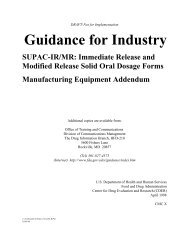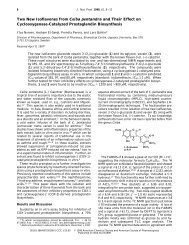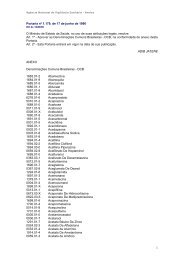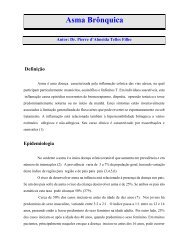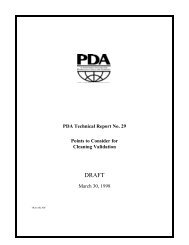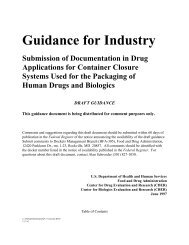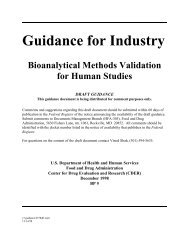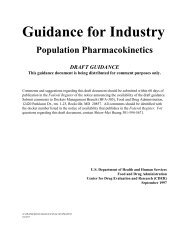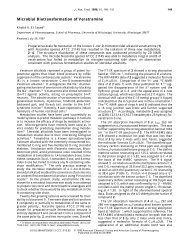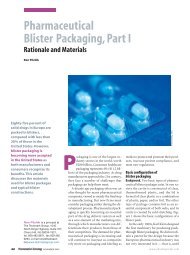ANDAs impurities in drug substances - Pharmanet
ANDAs impurities in drug substances - Pharmanet
ANDAs impurities in drug substances - Pharmanet
- No tags were found...
You also want an ePaper? Increase the reach of your titles
YUMPU automatically turns print PDFs into web optimized ePapers that Google loves.
207VII.QUALIFICATION OF IMPURITIESDraft-Not for Implementation208209210211212213214215216217218Qualification is the process of acquir<strong>in</strong>g and evaluat<strong>in</strong>g data that establishes the biological safetyof an <strong>in</strong>dividual impurity or a given impurity profile at the level(s) specified. The DMF holder orthe applicant should provide a rationale for select<strong>in</strong>g impurity acceptance criteria based on safetyconsiderations. The level of any impurity present <strong>in</strong> a <strong>drug</strong> substance that is <strong>in</strong> compliance with aUSP specification or has been adequately evaluated <strong>in</strong> comparative or <strong>in</strong> vitro genotoxicity studiesor has been evaluated via an acceptable Quantitative Structure Activity Relationships (QSAR)database program is considered qualified for <strong>ANDAs</strong>. Impurities that are also significantmetabolites do not need further qualification.If data are not available to qualify the proposed acceptance criteria of an impurity, studies toobta<strong>in</strong> such data may be needed when the usual qualification threshold levels given below areexceeded:219220221222Maximum Daily Dose#2g/day>2g/dayQualification Threshold0.1 percent or 1 mg per day<strong>in</strong>take (whichever is lower)0.05 percent223224225226227228229230231232233234235236237238Higher or lower threshold levels for qualification of <strong>impurities</strong> may be appropriate for some<strong>in</strong>dividual <strong>drug</strong>s based on scientific rationale and level of concern, <strong>in</strong>clud<strong>in</strong>g <strong>drug</strong> class effects.For example, qualification may be especially important when there is evidence that such <strong>impurities</strong><strong>in</strong> certa<strong>in</strong> <strong>drug</strong>s or therapeutic classes have previously been associated with adverse reactions <strong>in</strong>patients. In these <strong>in</strong>stances, a lower qualification threshold level may be appropriate. Technicalfactors (manufactur<strong>in</strong>g capability and control methodology) may be considered as part of thejustification for selection of alternative threshold levels. Proposals from applicants for alternativethreshold levels will be considered by the FDA on a case-by-case basis.The Impurities Decision Tree for generic <strong>drug</strong>s (Attachment I) describes considerations for thequalification of <strong>impurities</strong> when thresholds are exceeded. In some cases, decreas<strong>in</strong>g the level ofimpurity below the threshold, rather than provid<strong>in</strong>g additional data, may be the simplest course ofaction. Alternatively, adequate data may be available <strong>in</strong> the scientific literature to qualify animpurity. The studies that should be performed to qualify an impurity will depend on a number offactors, <strong>in</strong>clud<strong>in</strong>g the patient population, daily dose, and route and duration of <strong>drug</strong>adm<strong>in</strong>istration. Such studies are normally conducted on the <strong>drug</strong> substance conta<strong>in</strong><strong>in</strong>g the<strong>impurities</strong> to be controlled, although studies us<strong>in</strong>g isolated <strong>impurities</strong> are acceptable.J:\!GUIDANC\2452DFT.WPDJuly 21, 19988



